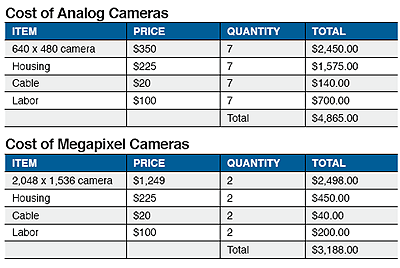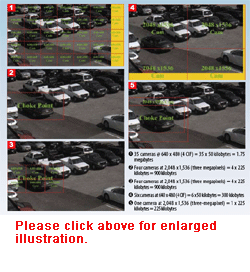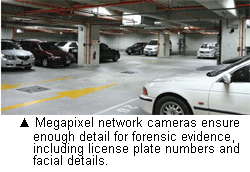Why are end users switching to megapixel technology? Despite conventional wisdom that reliable, industrial-quality megapixel network cameras are three or even four times more expensive than comparable low-resolution (4CIF) cameras, megapixel cameras are in fact cheaper.
Why are end users switching to megapixel technology? Despite conventional wisdom that reliable, industrial-quality megapixel network cameras are three or even four times more expensive than comparable low-resolution (4CIF) cameras, megapixel cameras are in fact cheaper.
Before looking at any camera or NVR/DVR combination, users define goals, which can be narrowed into three broad categories. General surveillance applications involve live view, where users do not need detail on recorded video. This may include watching a road, looking for traffic jams or observing crowds. Second is forensic, which require seeing, recording and recognizing images like license plates and faces. Third is high-detail, where users need to read license plates and also model of car. In a retail or banking context, operators need to clearly see customer and employee faces, as well as identifying currency in their hands.
Assigning a category to an application means defining resolution. With older surveillance technology, resolution was defined by total video lines (TVL). The market now defines resolution by the total number of pixels. This is more objective when comparing products that have different resolutions. For example, an image that is 640 (horizontal or columns) pixels by 480 (vertical or rows) pixels delivers a total of 307,200 pixels, or approximately 0.31 of a megapixel (1 million pixels) (see Figure 1). Resolution can be defined only by pixel when width of an area those pixels will cover is determined.
General surveillance applications require approximately 20 pixels per foot, forensic about 40 pixels per foot and high-detail at least 80 pixels per foot. To cover a parking lot (100 feet wide) with forensic detail means multiplying 100 feet by 40 pixels per foot for a total of 4,000 pixels.
The next step is to determine resolution. This is done by dividing the number of pixels to cover the area (in this case 4,000) by number of horizontal (columns) of pixels provided by the camera. With 320 by 240 resolution cameras (0.07 megapixels), the amount needed is 4,000/320 = 13 cameras (or 12.5). At
640 by 480 (0.31 megapixels), this would be 4,000/640 = 6.25 so at least seven cameras. For 1,280 by 1,024 (1.3 megapixels), it would be 3.25 so four cameras (Figure 4). At 2,048 by 1,536 (three megapixels), two cameras will do the job.
Price
A high-quality camera made by an established manufacturer that delivers a 640 by 480 image has a manufacturerˇs suggested retail price (MSRP) of about US$350, while that of one with 2,048 by 1,536 is $1,249. A high-quality outdoor heater and blower housing has an MSRP of $225 and 100 feet of Cat 5 cable can be purchased for $20 (cheaper than coaxial). Include $100 of labor to install each camera and do the math (see ¨Cost of Analog Cameras〃).
 This is a simple model, but it demonstrates an important fact: With wide areas to cover, megapixel is cheaper, though storage presents additional concerns. While a megapixel image is certainly larger than a 640 by 480 image, new smart-camera tools narrow the difference. With everything at the same compression, two images from a three-megapixel camera typically use less storage than seven images from a 640 by 480 camera (see "Cost of Megapixel Cameras").
This is a simple model, but it demonstrates an important fact: With wide areas to cover, megapixel is cheaper, though storage presents additional concerns. While a megapixel image is certainly larger than a 640 by 480 image, new smart-camera tools narrow the difference. With everything at the same compression, two images from a three-megapixel camera typically use less storage than seven images from a 640 by 480 camera (see "Cost of Megapixel Cameras").
Bandwidth and Storage
While there are many different types of compression H.264, MPEG-4 and M-JPEG there are basically two types: frame-by-frame and temporal. M-JPEG is the most popular frame-by-frame compression technique, compressing each image in its entirety. It is widely deployed and easy to integrate. The advantage is that it enables users to recreate images accurately and bandwidth use is predictable. The drawback is that by handling each image in its entirety, it is not efficient in terms of bandwidth when there is little motion or activity.
Temporal is represented by popular compression methodologies like H.263, H.264 and MPEG-4. These techniques are deployed in applications where network bandwidth is limited and low-quality images will suffice. Temporal takes an image called a "key frame," compresses it in its entirety, then for the next few images, only compresses and transmits things that change in the image. Every few images, it takes another key frame and repeats the process. The advantage is that by sending only changes to the key frame, users save bandwidth and storage when there is little motion or activity. One drawback is that only the key frame is a true legal picture. Another drawback is that motion significantly increases bandwidth consumption, reducing the bandwidth advantage over frame-by-frame compression.
When does megapixel make sense? A number of cameras options can achieve forensic detail. To determine bandwidth for each option, calculate the size of each image and keep compression for all cameras the same. Once image size is determined, multiply that by images per second to get bandwidth requirements. According to Milestone, a 640 x 480 image with medium-low compression is about 50 kilobytes. For higher resolution images, IQinVision's comparison matrix shows a typical 3.1-megapixel image has a file size of 225 kilobytes.
The following examples show what it would take to cover a parking lot with the desired resolution.
A comparison reveals that megapixel cameras deliver the same image quality for about half the bandwidth. Most people, however, will not employ cameras to cover entire areas. To save money, they are likely to use cameras at critical choke points, so the 35-camera to four-camera comparison is not practical. Take a look at a choke point to see how megapixel cameras stack up. First, define choke point area the area where something to record is likely to happen (Figure 2).
The example demonstrates that covering the choke point with a megapixel camera uses 33 percent less bandwidth than using six 4CIF, 640 by 480 cameras (Figure 3).
More sophisticated megapixel cameras incorporate features such as digital image cropping, allowing the user to optimize a camera for a given application. Essentially, they crop out areas that are not needed and save corresponding bandwidth. In the above example, the choke point is 1,920 by 960, so the 3.1-megapixel camera could be cropped to 1,920 by 960 and still cover the area. This should yield a file size of 135 kilobytes, 42 percent smaller than covering the same area with 640 by 480 cameras (Figure 5).
 Digital versus Mechanical PTZ
Digital versus Mechanical PTZ
Mechanical pan, tilt and zoom cameras consist of motors, slip rings, gears and/or belts and wheels. Traditionally, they were controlled by proprietary keyboards, but now can be controlled by software. These devices are available as integrated units, most commonly domes, or cameras can be purchased separately and mounted on a pan-tilt motor. The amount of zoom depends on the ratio of telephoto to wide-angle setting. A lens that goes from four millimeters to 100 millimeters will have a 25x zoom. A lens that goes from 50 millimeters to 150 millimeters will provide only 3x zoom, but will be much better at zooming in farther away because of the 150-millimeter telephoto setting. This, however, will not have as wide angle a setting (50 millimeters) as the 25x lens (four millimeters).
Today, most mechanical PTZ cameras employ low-resolution cameras, typically around 704 x 480 or one-third of a megapixel. To get high-detail (80 pixels per foot) with such a camera, zooming into an area that is no wider than eight feet would be required. Zooming out all the way would be spreading those pixels out over a wide area and would lose all detail.
If the goal is to give security staff ability to monitor general activity then zoom in over a long distance with good detail, mechanical PTZ cameras with high-zoom telephoto lenses are the way to go, but there are a few things to consider. First, mechanical PTZ cameras should be thought of as either/or. Users either get wide-area coverage with low resolution or high resolution in a very narrow area.
The second thing to consider is cost of 24/7 guards dedicated to controlling cameras a substantial amount of money. Next, if controlling cameras over a TCP/IP network, there is often a delay between the command to PTZ and when the camera responds. Finally, mechanical PTZ cameras have moving parts that wear out and require periodic maintenance and repair.
The other approach is to use megapixel network cameras with digital pan, tilt and zoom. Megapixel network cameras are ideal for applications where there are insufficient resources to have 24/7 live monitoring of cameras and where users need to rely on the forensic value of recorded video. When combined with the right lens, megapixel network cameras ensure enough detail for forensic evidence. This includes license plate numbers and facial detail.
After deciding to opt for megapixel network cameras, the only thing users have to do is make sure that they have selected proper resolution and lenses to provide desired detail (pixels per foot). Once configured, operators can digitally pan, tilt or zoom around live images without affecting what is recorded. In fact, multiple  people can connect to the same camera at the same time and independently pan, tilt and zoom. Regardless of where users may be digitally panning, tilting or zooming, they can always go back to recorded video and look at other areas with no loss of detail. Additionally, since megapixel cameras have no moving parts, there are virtually no maintenance requirements.
people can connect to the same camera at the same time and independently pan, tilt and zoom. Regardless of where users may be digitally panning, tilting or zooming, they can always go back to recorded video and look at other areas with no loss of detail. Additionally, since megapixel cameras have no moving parts, there are virtually no maintenance requirements.
Different PTZ technologies are available. With 24/7 guards, the ability to live zoom on a small object far away is critical. Less important is quality and digital zoom of recorded images. For this, a mechanical PTZ camera solution may be the better choice. If, on the other hand, users cannot afford to miss a thing, fixed megapixel network cameras are clearly the right choice.